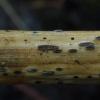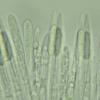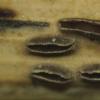
20-12-2025 23:08
Patrice TANCHAUDBonsoir, récolte sur sol sablonneux dans l'arri�

21-12-2025 09:32
Hello.A tiny ascomycete found embedded in wood in

20-12-2025 15:47
Mirek GrycHi.These grew on pine wood that was heavily covere

18-12-2025 21:17
Pol DebaenstThe identification took me to Byssonectria deformi

15-12-2025 07:09
 Danny Newman
Danny Newman
indet. Rutstroemiaceae sp. on unk. fallen leavesMc

19-12-2025 10:10
Patrice TANCHAUDBonjour, récolte réalisée en milieu dunaire, a

18-12-2025 17:23
 Bruno Coué
Bruno Coué
Bonjour,je serais heureux d'avoir votre avis sur c
Erumpent on Phragmites australis
Juuso Äikäs,
06-06-2020 20:25
Spore dimensions:
(6.5) 6.6 - 7.2 (7.3) × 2.1 - 2.4 (2.5) µm
Q = (2.8) 3 - 3.2 (3.3) ; N = 8
Me = 6.9 × 2.2 µm ; Qe = 3.1
Juuso Äikäs,
07-06-2020 13:54
Re : Erumpent on Phragmites australis
I managed to find one rather promising candidate: Hysterostegiella valvata.
http://www.centrodeestudiosmicologicosasturianos.org/?p=23617
In that source the substrate is apparently Ammophila arenaria, so Poaceae as well. Paraphyses look just right and spore size and appearance is also pretty much the same.
http://www.centrodeestudiosmicologicosasturianos.org/?p=23617
In that source the substrate is apparently Ammophila arenaria, so Poaceae as well. Paraphyses look just right and spore size and appearance is also pretty much the same.
Juuso Äikäs,
07-06-2020 15:32
Re : Erumpent on Phragmites australis
I have to clarify that in the first pic I think at least a part of those are actually Lophodermiums or something like that. I re-examined the sample and they had filiform spores. Both species are growing on the same culm near eachother. Here's a pic that I think is of the possible H. valvata:




